FINAL REPORT: Cowpea Atlas
September 10, 2024
Feed the Future Innovation Lab for Legume Systems Research
Final Report
Project Title: Cowpea Atlas
Executive Summary
Cowpea [(Vigna Unguiculata (L.) Walpers] is one of the most important seed legumes in the arid and semiarid zones of Africa with considerable economic, nutritional, and agronomic benefits. Cowpea grains are a valuable source of vegetable protein and are rich in lysine and tryptophan and serve as off-season food for rural population. They contain a significant amount of minerals and vitamins (folic acid and vitamin B) necessary for the prevention of congenital malformations (Diouf 2011). The crop is mainly grown by smallholder farmers (Murdock et al., 2013) and is well integrated in the cropping systems. In Sub-Saharan Africa, the potential effect of cowpea nitrogen fixation, is estimated to be 77,320 for the period 2011–2020 (CRP GL, 2012). Cowpea production and consumption contribute to diet diversification and nutritional security. Increased consumption of nutrient dense grains like those of cowpea is then encouraged to increase food and nutritional security in West Africa (FAO et al. 2018).
Cowpea has also a huge potential in terms of derived products and utilization (canned, whole and decorticated flour, infant food), which is still largely untapped in the sub-region (Phillips, 2013). The factors constraining the diversification of cowpea utilization across agro-ecological zones in the sub-region are poorly documented, limiting value addition in cowpea value chains. In addition, cowpea production and marketing systems are constrained by social, cultural and economic factors, which need to be identified and tackled to enable farmers to take advantage of existing national and export markets (Murdock et al., 2013). Addressing sociocultural and/or economic motivators or barriers to cowpea utilization at various stages and scales within production and market systems in target countries is a pre-requisite to improve cowpea production, processing and marketing systems. This aligns perfectly with the Objective 11 of the US Government Global Food Security Strategy, namely “Inclusive and sustainable agricultural-led economic growth” through (i) Increased sustainable productivity of cowpea smallholder farmers; (ii) Stronger inclusive market systems for cowpea derived products and (iii) Improved infrastructure, including digital and other ICT devices through the development of digital atlas on cowpea in the target countries.
In recent years, there have been a number of projects and initiatives (e.g.: West Africa cowpea consortium focusing on variety development, Increasing Cowpea value chain sustainability in West Africa through product and process innovation) at national and regional levels, to improve cowpea value chains in West Africa. However, these initiatives are scattered and poorly integrated, leading to inefficient resource utilization and low investment. Availability of reliable data on each segment of the cowpea value chains is a main challenge including the identification of priority intervention areas in the value chains which makes difficult the local and regional interventions. Compiling and making information on the various segments accessible, through an online platform, is of utmost importance to identify information gaps, research and priority areas of investment in cowpea value chains in the target countries. This will lay the ground for strengthening global commitment to investing in food security by promoting cowpea value chains.
The present “COWPEA ATLAS PROJECT” has been designed to ensure an inclusive and sustainable agricultural-led economic growth by developing a digital platform through (phase 1) the mapping of cowpea data sources and data gaps along cowpea value chains in West Africa and (phase 2) the development of a virtual cowpea atlas platform which will include existing data on cowpea value chains in West Africa with the 4 target countries, Benin, Nigeria, Niger and Senegal selected for case studies.
Project Partners
The project was managed by CERAAS which is a regional research and training institution based in Thies (Senegal) with 37 years of experience in crop improvement through the development of new varieties (tolerant/resistant to drought and other stresses) and a strong experience in agricultural project development. CERAAS has partnership with many institutions including, national research institutions, universities, national and international NGOs, multilateral donors. To facilitate the implementation and management of this project, CERAAS collaborates closely with universities and research institutions in Benin, Nigeria, Niger, Senegal the target countries, and the Legume Innovation Lab at Michigan State University. The collaboration has been established in:
- Benin, with “Department of Genetics, Biotechnology and Seed Sciences of the University of Abomey-Calavi” (GBioS);
- Niger, with “National Agricultural Research Institute of Niger (INRAN)”;
- Nigeria, with “Institute for Agricultural Research of Ahmadu Bello University (IAR/ABU);
- Senegal, with “Bureau d’Analyses Macro-Economiques (BAME) of the Institut Sénegalais de Recherches Agricoles (ISRA).
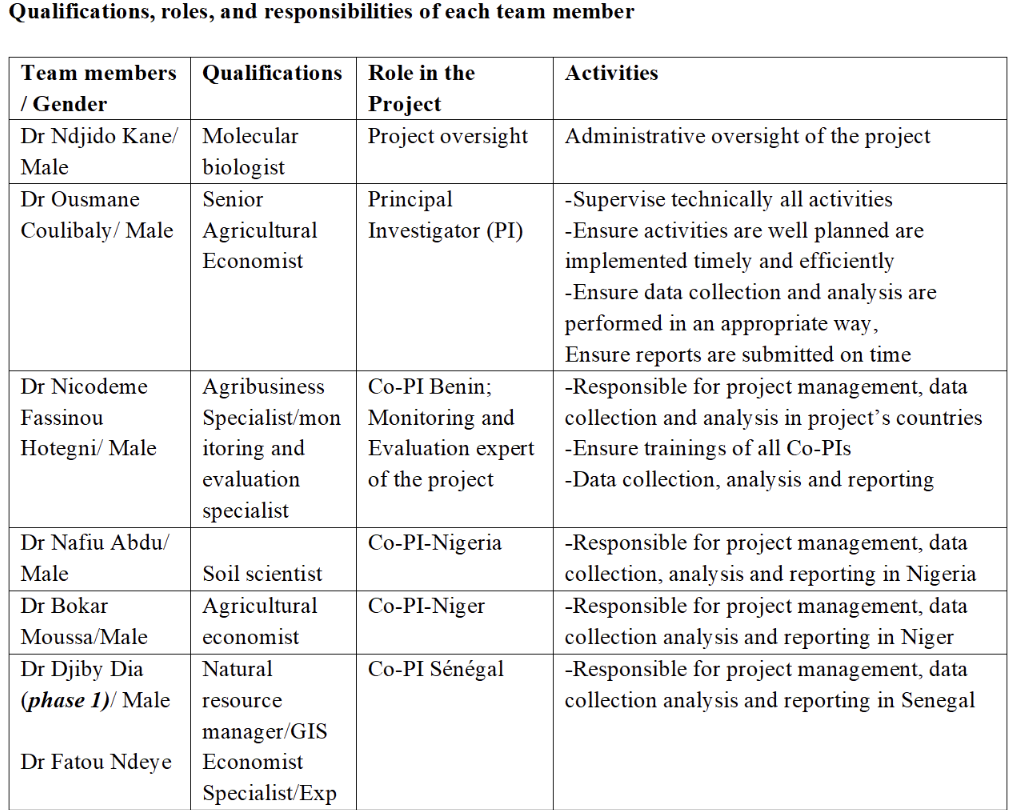
![]()
In addition to the main team of management, additional recruitment has been conducted to ease the implementation of the project activities to avoid delays.
Project Goals and Objectives
The global objective of the project was to establish an inclusive and sustainable agricultural-led economic growth through the identification of sociocultural and/or economic motivators and/or barriers to cowpea utilization at various stages and scales within production and market systems in Benin, Nigeria, Niger and Senegal. These countries cover a spectrum of diversity in agro-ecological zones, cowpea production and market systems in West Africa.
Phase 1: Map cowpea data sources and gaps along cowpea value chains in West Africa, specifically: (i) identify cowpea data sources along the cowpea value chains in target countries and (ii) assess cowpea data sources and gaps along the cowpea value chains in target countries.
Phase 2: Development of a virtual cowpea atlas platform which will include existing data on cowpea value chains in West Africa, specifically: (i) fill relevant cowpea data gaps identified during Phase 1 with a focus on traders-driven, (ii) design and deploy an interactive e-cowpea platform for easy access of cowpea traders to timely information on cowpea value chains (iii) document sociocultural and economic motivators and barriers to increased cowpea production and consumption in target countries; (iv) put in place a sustainable strategy to keep the platform running beyond the project life span.
Overview of Activities
To achieve the project's objectives, specific activities have been designed and broken down into easily achievable tasks or sub-activities. All these tasks are presented below (table).
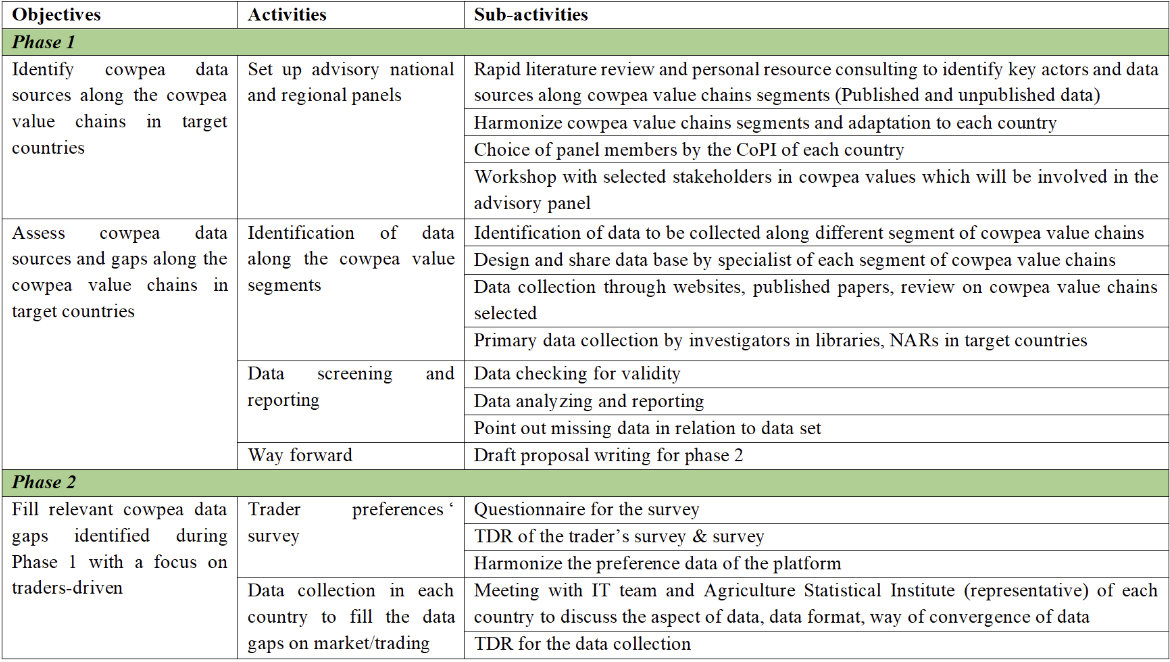
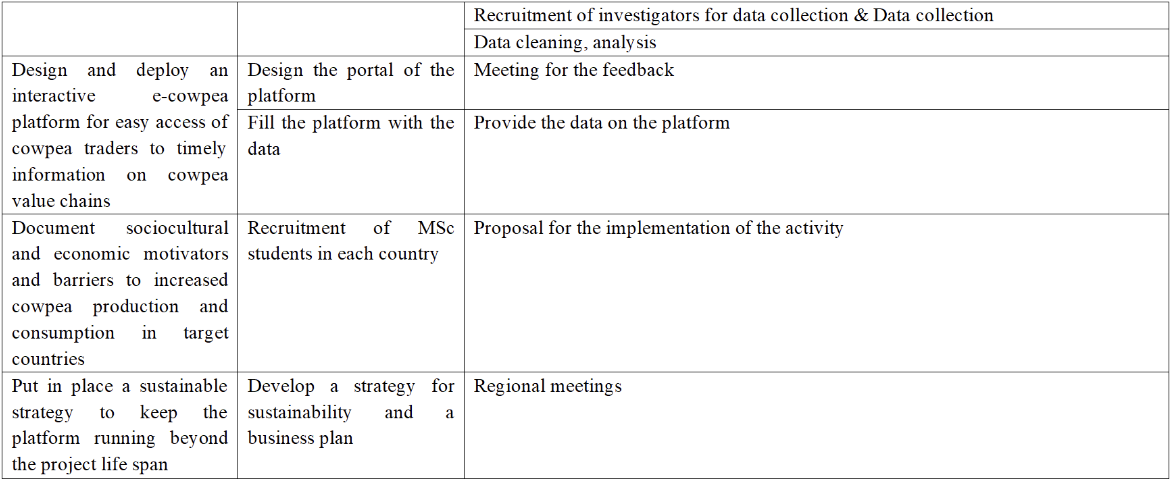
Accomplishments
I. Achievement phase 1
1. Set up national advisory panels
In each target country, investigations in the cowpea sector have been done to identify the qualified actors to lead effectively the advisory panel. The number of members varies between 10 and 15 and include producers, traders, scientists, extensionists, statisticians from public institutions, members from NGO and the private sector. Each panel member has signed a commitment letter to serve in the panel and to be a liaison officer between their institution and the project. The main role of the national panel is to contribute to data gap filling and continue the data supply at the end of the project in a sustainable manner.
The advisory panel in Benin was set on February 16th , 2022 in the Conference room of the Laboratory of Genetics, Biotechnology and Seed Sciences (GBioS) of the University of Abomey-Calavi.
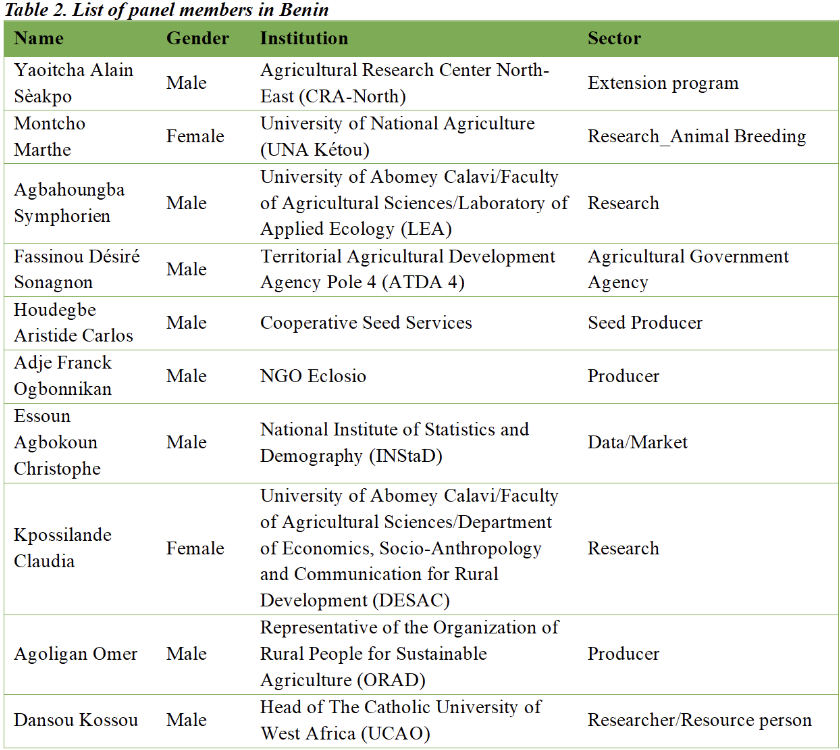
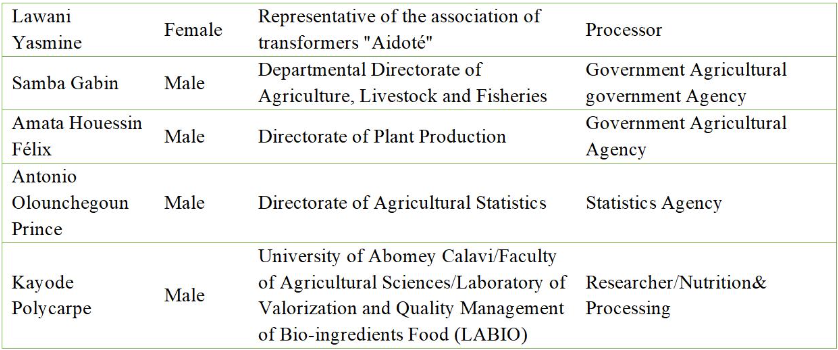
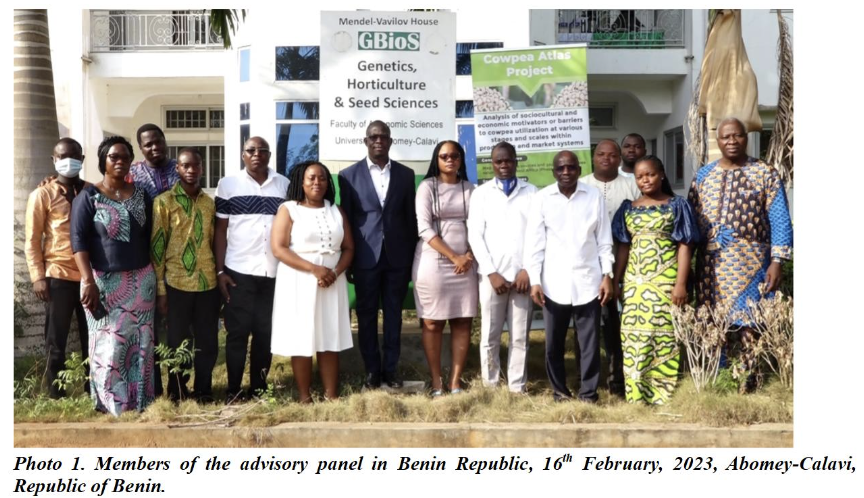
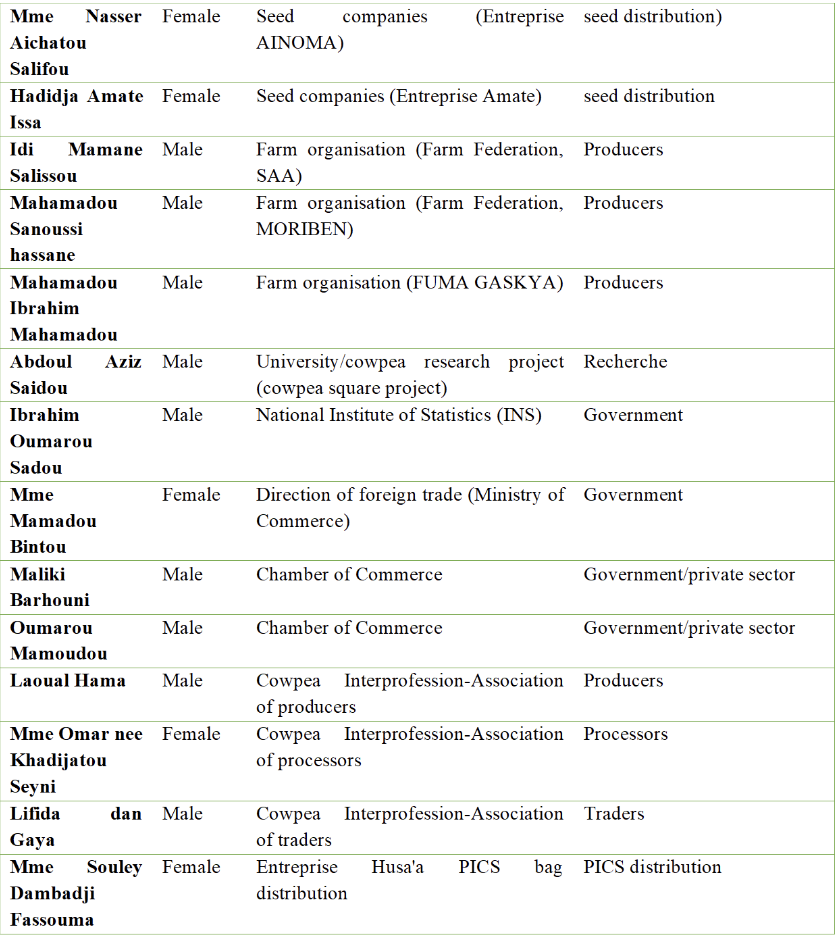
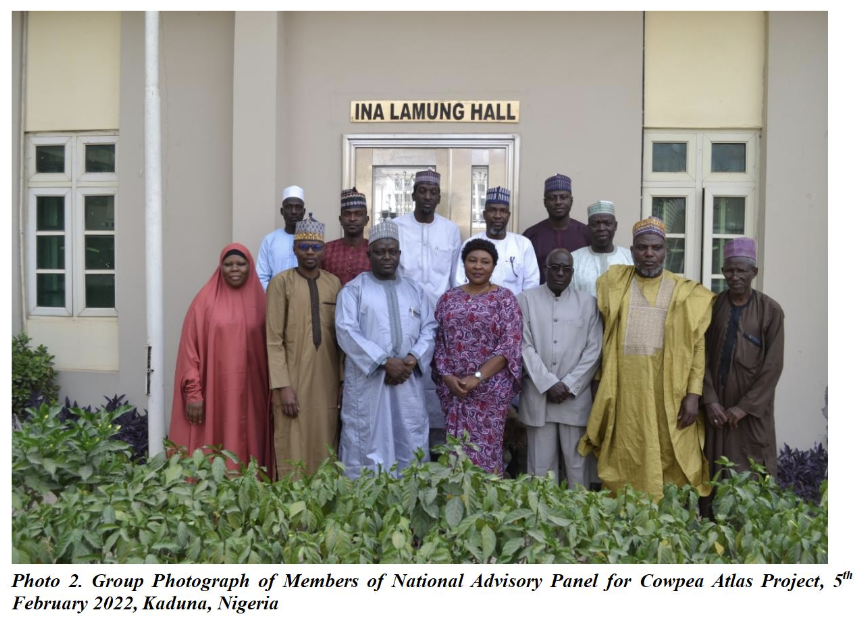
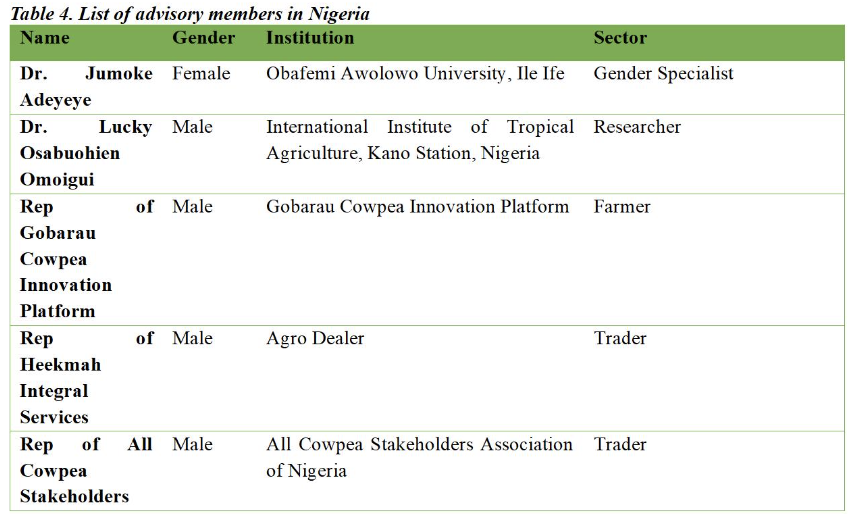
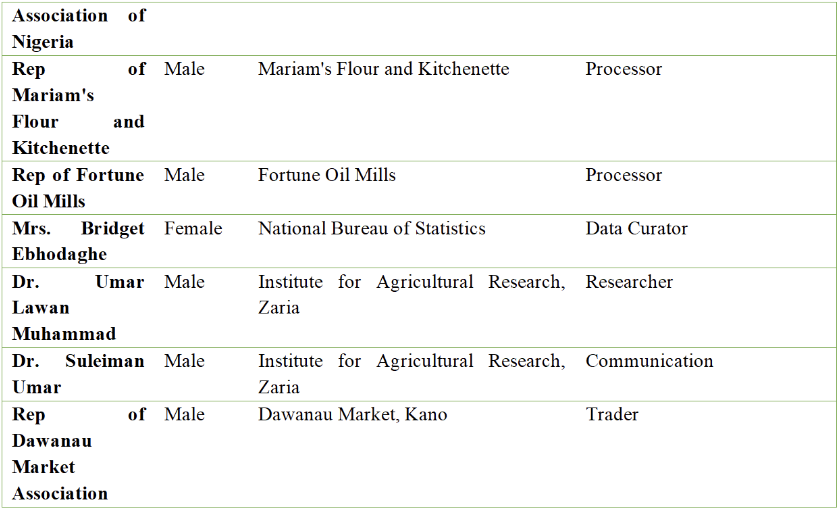
2. Identification of data along the cowpea value segments & data screening and reporting
Data to be collected along cowpea value chains were identified based on the types of data expected from different sources and disaggregation levels in the Phase 1 proposal. Some platforms which could be sources of data in cowpea values chains were selected and presented (FerSerWAM, FAOSTAT, FAM, UNCOMTRADE, PARBA, etc.) in the proposal. These platforms were consulted by each national team and data was collected from them. As far as physical data collection was concerned, the target segments having been defined, each national team collected data according to its own methodology and the questionnaires developed by the whole team of the project.
- In Benin, online platforms were assessed through a rapid literature review and intensive secondary data collection. Concerning physical data collection, it has been done through a digitalized questionnaire on KoboCollect app and deployed on tablets. Enumerators were chosen, trained and sent to existing data sources (IITA, INRAB’s centers, ATDA, FUPRO-Benin and Universities, etc.). Enume
- In Niger, enumerators hired were trained to use the KoboToolbox platform and the KoboCollect application to digitize, deploy and conduct interviews in order to collect the necessary data. Physical data collection was done on each segment of the cowpea value chain.
- In Nigeria, a team of five proficient data collectors utilized the KoboCollect App as their primary tool for gathering data across diverse segments of the value chain. Through the KoboCollect platform, comprehensive questionnaires were meticulously formulated and subsequently uploaded onto Android devices. Engaging with input suppliers, seed dealers, producers, consumers, markets, farm-to-market operators, and processors, the enumerators did interviews using a semi-structured questionnaire to obtain the required information from the respondents. These interviews were conducted in English, while in cases where respondents did not possess English proficiency, the interviews were skillfully carried out in the Hausa language.
- In ISRA/BAME in Senegal, most of data platforms were identified and the extraction of data basis has been done. The most common platforms used were FAOSTAT, AGRIDATA, PAPA Project, DAPSA database, ANSD database, SIM CSA platform. Those datasets have been rearranged by two statisticians that joined the research team.
All collected data per country were centralized in an Excel sheet (available here and attached to this report). Data were checked first for validity by cross checking collected data and parsing them at data manager level and Co-PI level. Parsed data where share with the regional data manager for reporting using Google Data Studio/Looker Studio dashboard. Gaps in collected data were identified at country level and reported in an Excel sheet (available here and attached to this report).
II. Achievement phase 2
- Regional workshop at Senegal
Held on 19 and 20 December 2022, the objective of the workshop was to share an understanding of the activities to be carried out with all the implementing partners from Benin, Niger, Nigeria, and Senegal. Specifically, the objective was to define the roles and responsibilities of implementing partners including institutions in charge of agricultural statistics at the national level. In short, the project team aimed at providing answers to the following questions:
- What were the mains outputs of the Phase 1 of the project?
- What are expected from each stakeholder (developer team, institutions, national statistics) in the implementation of the Phase 2 of the project?
At the end of the meeting, it was decided that each country will have a local platform/server for data gathering. Every participant came out with a clear understanding of what was expected from them. It is also important to notice the participation in the meeting of some members of the advisory panel set up during phase 1 including representatives of the National Bureau of Agricultural Statistics which will ensure the sustainability of the platform at the end of the project.
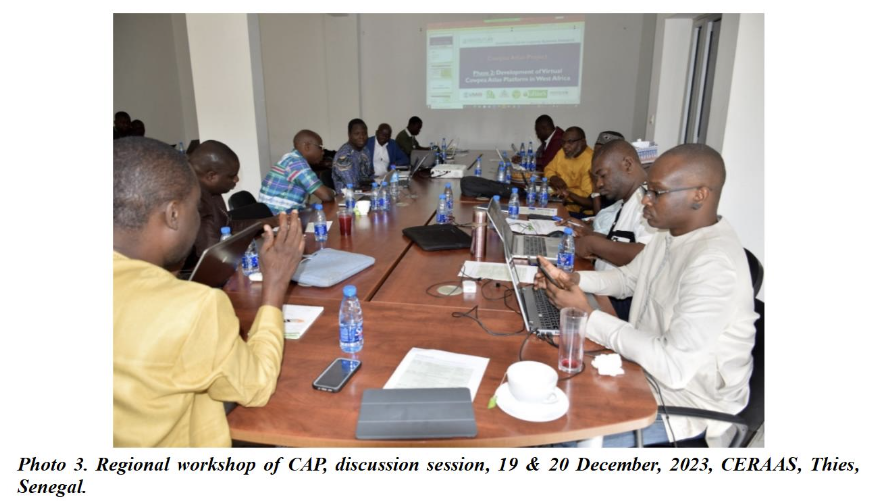
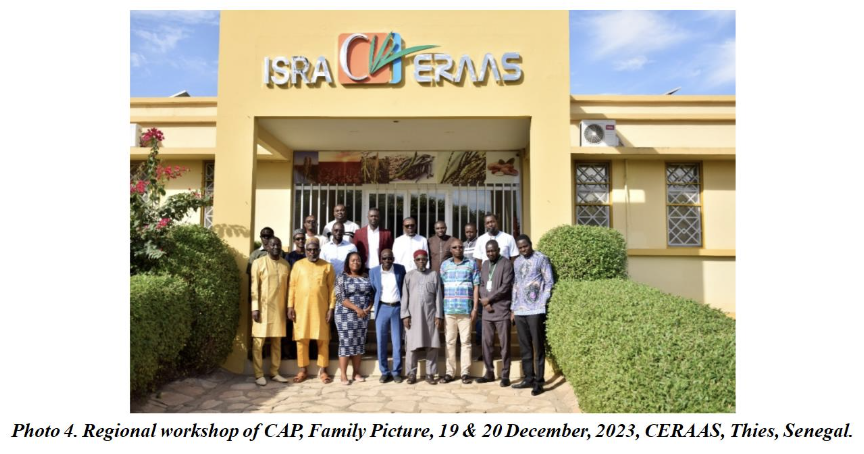
1. Trader preference survey preference
A questionnaire has been developed (via annex 1) by the agricultural economists, members of the team and was planned to be executed by the countries involved in the project.
- In Nigeria, the team proceeded with the training of primary data collectors on Focus Group Discussion. The training was attended by all the five data collectors, the Project Scientists, and the Project Co-PI. An in-depth training on the methodologies and techniques on data collection done by the resource person. Following the training, focus groups discussions with the platform users i.e., cowpea merchants, processors, and institutional buyers have been done. They were conducted in February and March 2023 across 2 states (Kaduna and Kano) and involved cowpea merchants, processors and institutional buyers.
2. Designing the portal of the platform
- As scheduled, the portal of the platform was designed by the developer team of CERAAS to serve as a (i) regional pool for exchange of information and knowledge among cowpea value actors in each country and (ii) gather quality data for sound decision making by stakeholders. For more details click here.
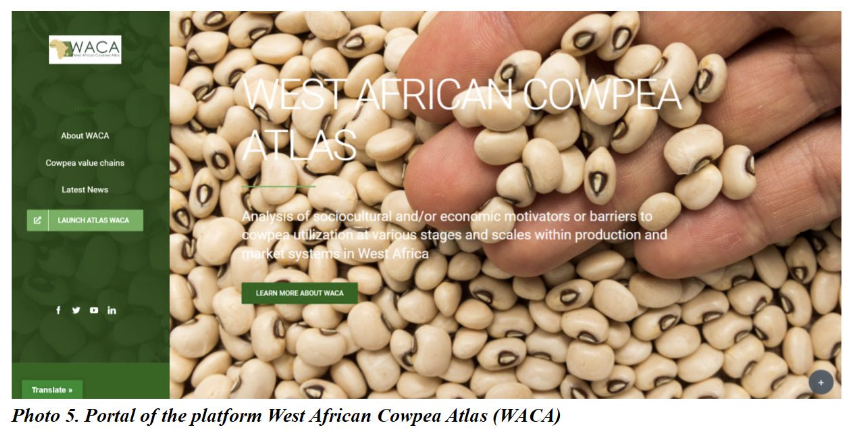
3. Identification of the barriers to cowpea production and consumption
- In each country masters’ students were hired to conduct a survey of the barriers to cowpea production and consumption. The results will be used in designing future interventions in the target countries. In each country, a panel of scientists was set to coach the students for effective quality work. The studies are still ongoing.
Mission, workshop, conference & capacity building
Phase 1
Monitoring, evaluation and training in Niger, Nigeria and Senegal
In order to assess the progress of activities carried out within the framework of the Cowpea Atlas project, a Monitoring and Evaluation mission was held from 28 May - 04 June 2023, by the Benin team in the project's partner countries: Niger, Nigeria and Senegal. The team in charge of the Monitoring-Evaluation 14 of the project visited project partners in Senegal and Niger and provide them with tools for accurate and timely data collection using tablets (Kobocollect). It was also the moment to discuss on the implementation of the second phase relative to the “Designing of the digital platform on Cowpea”.
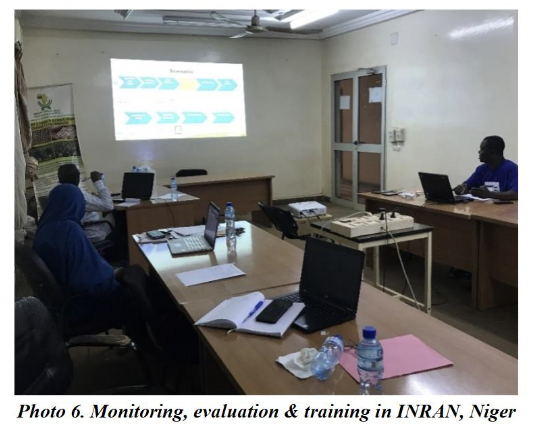
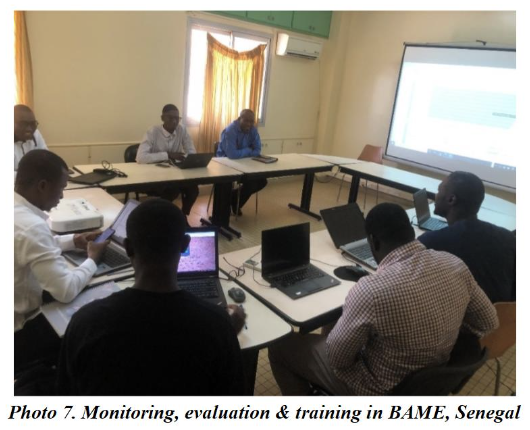
Phase 2
Visit of the project Management Entity Team
The physical meeting with the Legumes Innovation Lab (LIL) Management Entity team held in November 2022: the Director and Deputy director of LIL, Drs Barry Pittendrigh and John Medendorp visited the implemented institutions of the project in Senegal, Benin and Niger. The meetings provided a better understanding of the project activities and the development of the e-platform.
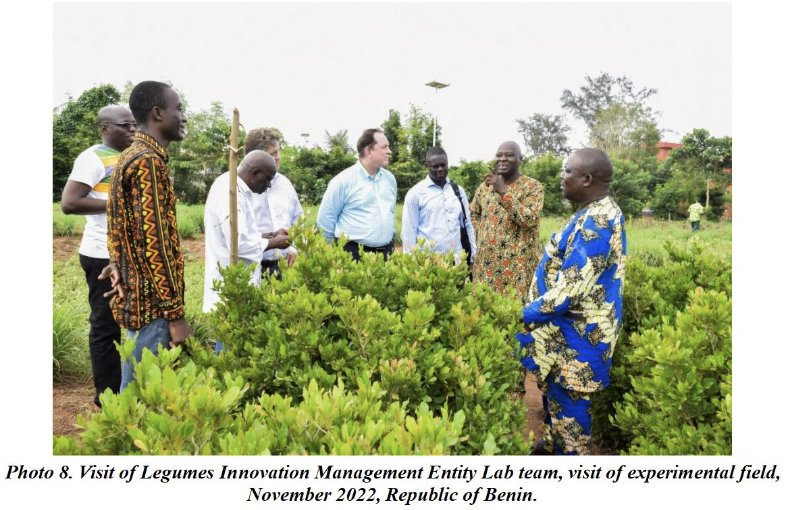
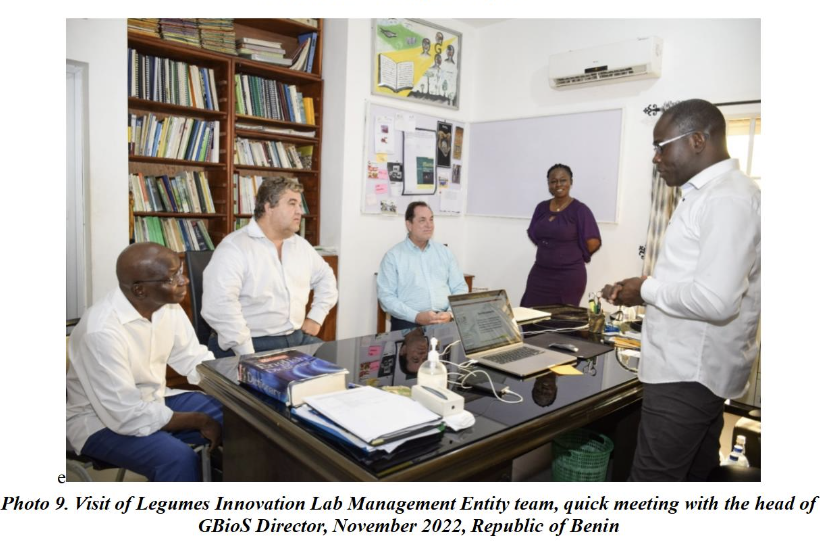
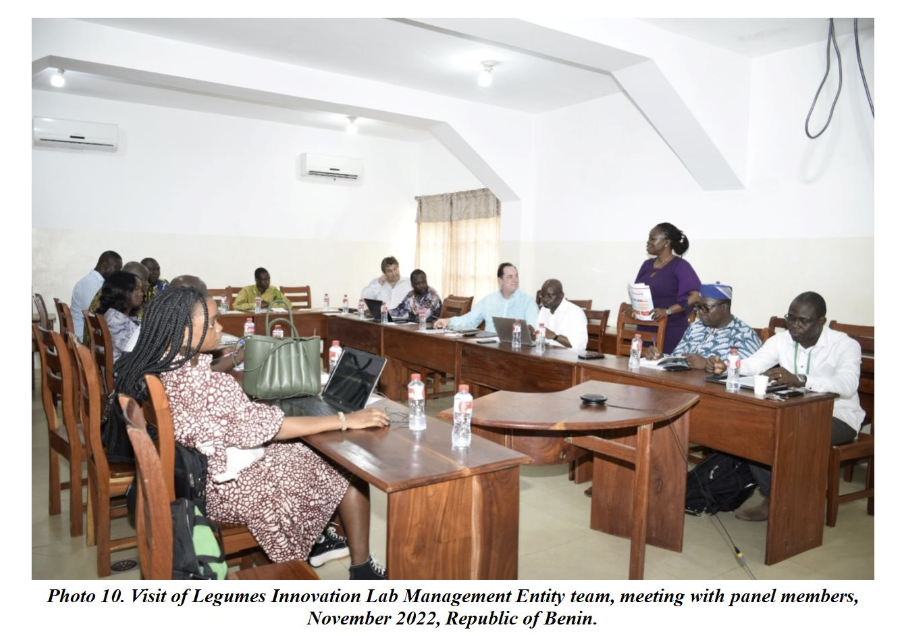
Global convening conference at Zambia
Participation of the team in the Global convening conference organized by LIL in Zambia. It was the place for the project team to share ongoing and future activities of the project and get comments from the audience in terms of better platform quality. The conference was held at Zambia from February 20-24, 2023 with the participation of the representative members of the target countries of the project as well as the PI.
Title of presentations
- Regional initiative around cowpea value chains in West Africa for better food and nutrition security: Cowpea Atlas Project, by Ousmane Coulibaly
- In Nigeria men dominate most of the cowpea value chain segments: findings from cowpea atlas data mapping and gap identification project, by Nafiu Abdu
- Revitalizing cowpea value chains in West Africa for better food and nutrition security: case of cowpea atlas platform establishment in Benin Republic, by Yasmine L. Godonou
- Access to quality data for boosting cowpea value chain in Niger: the case of cowpea and cowpea products data for markets through an electronic platform, by Bokar Moussa
Highlights of Addressing Cross-Cutting Themes (HICD, Gender, Youth, Nutrition, Resilience)
In its implementation, this project deals with some cross-cutting issues such as gender, youth and, HICD (Human and Institutional Capacity Building). Those issues were addressed in the project design, implementation and in monitoring and evaluation.
- Project design: Gender, youth and capacity building of youth and institutions were clearly integrated in the design of this project. It has been proven that women and youth play a very important role in cowpea value chains in West Africa. Thus, the gender is strongly taken into consideration in the implementation of the project activities. Youth will also be trained under this project to develop their capacity to make sound decisions along cowpea value chains. Also, the institutions in charge of agricultural statistics and public data collection in the target countries will be strengthened in their capacity to collect and produce quality and usable data to feed the cowpea atlas platform and thus ensure its sustainability after the end of the project. Finally, project management staff will also be trained in new financial management tools, data and information management, monitoring and evaluation, and project management.
- Implementation: The gender-based advisory panels in each target country were heavily involved in the implementation of this project. Panel members contributed to the identification of data sources, the design of data collection tools, and the data collection process. All data collected were disaggregated by gender where applicable. In addition, youth were trained to build their capacity in project management, data management, and financial management.
- Monitoring: The monitoring was assured by 2 teams. A team at the national level and a supervisory team at regional level. The teams are composed of young people, trained during the project execution. They have been able to adapt and assist in the implementation and monitoring of the project activities and in the evaluation of the results.
- Evaluation: Youth are involved in the evaluation team. They will build their capacity in project evaluation. The project will also be evaluated for its impact on women's lives and income generation.
- HICD: The capacity strengthening at individual and institutional level has received some attention in the course of the project. The capacity of institutions involved in data collection, analysis and reporting mainly the public statistical bureau has been improved. The proposal writing capacity of the team and the data automation capacity of the regional data manager have been improved thanks to the Legume Innovation Lab. In addition, the capacity of the young staff involved in the project has been improved.
Utilization of Research Outputs and Handoff/Scaling of the Outputs
The output of this project is the electronic platform set to diffuse information to cowpea value chains actors for a sound decision making. Input dealers (seeds, fertilizers, pesticides), producers, processors, traders and consumers will be well informed in their business decision making. Individual and institutional capacity strengthening in data collection, analysis and reporting has improved the capacity of national teams for effective collaboration and quality data collection and use by stakeholders.
The scaling will be done at two levels:
- Commodity: The e-platform has been set around a single commodity- cowpea- to start with. Provision has been made for other commodities which may include legumes or cereals. Cowpea in 18 intercropped with groundnut, maize, millet and sorghum. Including these crops in the platform will optimize the systems and ensure its sustainability through increased production and higher incomes.
- Geography/Agroecology: Savana and Sahelian agroecological zones where cowpea is grown, are diversified with different access to markets of input and products and significant price variations across settings. Individual e-platforms can be conceived for homogenous agroecological and market settings to allow better use of given specific agroecological conditions and market prices of inputs and products for optimal management and higher incomes. Different platforms can be developed per country according to homogenous agroecological and access to markets and sets of prices for optimal decision making.
Further Challenges and Opportunities
1) The lack of quality data is still a challenge even for better-organized commodity value chains like cotton, maize or groundnut. The poor and lack of information in all or part of segments in the cowpea value chains are a constraint to good decision making. Statistics are scarce and cannot meet the current need for analysis.
2) The project’s well-documented list of activities and targets helped to convince the national advisory panel members to be committed and take over the supply of data to the e-platform after the end of the project. This is an element of sustainability of the project.
3) An important lesson learned from this work so far is the effective coordination between the national and the regional teams. Regular meetings and intensive communication have helped in keeping the activities on track.
Other challenges and opportunities
As the objective of the Cowpea Atlas project to design an interactive e-platform has not been completed achieved, another phase of this project will be relevant and useful. The secondary data sources are available and the primary data collection process is in place and there is now a great deal of data that can be capitalized on. The idea of setting up a multi-stakeholder platform, taking into account most of collected data is a great opportunity for this project. The next phase of the project will focus mainly on developing local, national and regional MultiStakeholder Platform (MSP) for effective and efficient market access, information, technology adoption and dissemination along the value chains. The MSP promotes knowledge exchange and information among stakeholders to enhance their participation in sound decision making process for food security and higher income. The direct target groups are producers, consumers, processors, traders across the cowpea value chains with special focus on women, youth and men. Indirect actors include input suppliers, extension agents, quality control agents, and interprofessional agents.



 Print
Print Email
Email

